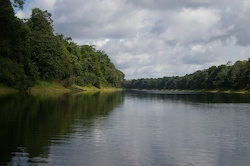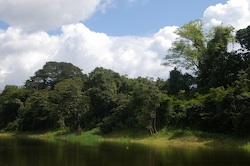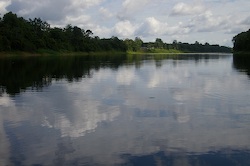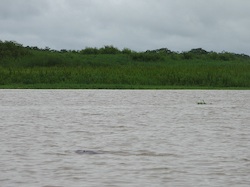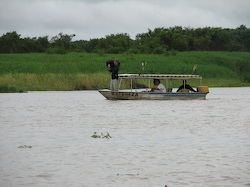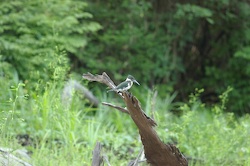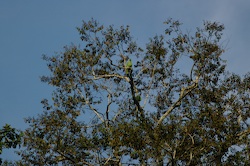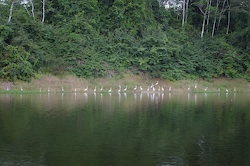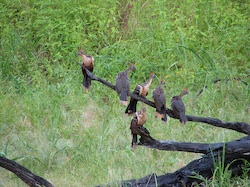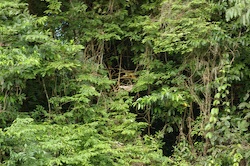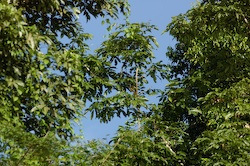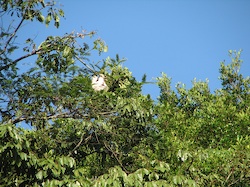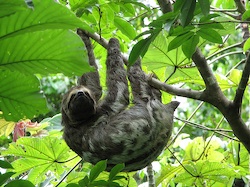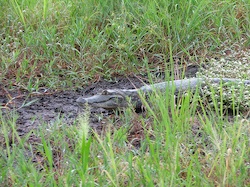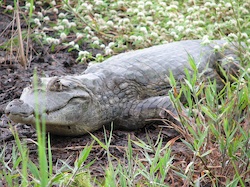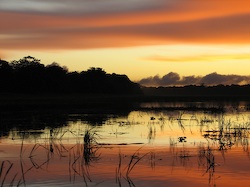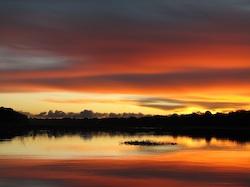|
MAMIRAUÁ BY BOAT Though we did some hiking on shore, most of our time in Mamirauá was spent at the floating lodge, in a canoe, or on a boat. One of the biggest highlights of our trip was a visit with Dr. Tony Martin and Dr. Vera da Silva, two biologists who have been studying the Amazon pink river dolphins (aka Botos) for many years. After a fascinating presentation by Dr. Martin about this long-term research effort called Project Boto, he joined us for a morning of Boto-spotting. We saw quite a few of them, but only for a moment or two at a time. I played the "try to get a photo of a Boto" game for awhile, but the first photograph above is all I have to show for it. The second photograph shows a camera crew from the Cousteau Society who were filming both the Botos and the Project Boto folks. We chatted with the Cousteau Society folks later at Uakari Lodge and discovered that one of them lives no more than 20 miles from Monica and me in California. We'll be looking for their Amazon show on PBS television in 2007. Not counting the caimans (and maybe even counting them), birds were the animals most commonly seen from a canoe or boat. Here's a small selection, from left to right: An Amazon Kingfisher (Chloroceryle amazona), a pair of (unidentified) green parrots, and a lineup of Great Egrets (Ardea alba). The most beautiful birds we saw were a pair of Scarlet Macaws caught in the golden hour before dusk, flying over the river. My favorite Mamirauá birds were the hoatzins (Opisthocomus hoazin). On one boat trip to Lake Mamirauá, we saw dozens of these strange critters in groups perched in foliage along the water's edge. Baby hoatzins have claws on their wings that are reminiscent of fossils of Archaeopteryx, among the earliest birds. They use these claws to help maintain a grip on the branches that they clumsily navigate in their ungainly youth. The adults don't have the wing claws, but they're still relatively clumsy, and they have silly hairstyles. We saw a number of monkeys while floating in canoes, but they didn't sit still for pictures. These photographs are intended merely as proof that we saw monkeys. We ended up seeing five kinds: common squirrel monkeys, black squirrel monkeys, capuchins, red howlers, and one lone distant silhouetted white bald uakari. The one just barely pictured here is a common squirrel monkey. We also ended up seeing a few sloths, of both the two-toed and three-toed species. At Mamirauá they were all far away, high up in trees, like the first one pictured here (a larger, whiter, two-toed sloth). Later on our trip, we were lucky enough to see a sloth up close at Ariaú Towers, near Manaus, where Monica took the second photo (a smaller, browner, three-toed sloth). We saw dozens of Black Caimans at Mamirauá, which spend almost all their time floating in the water. The caiman pictured here was our one and only Spectacled Caiman (Caiman crocodilus). These are generally seen hanging out on the shore. On our final afternoon in the reserve, we took a boat out to Lake Mamirauá and paused to watch this spectacular sunset while the crickets chirped, the frogs croaked, the caimans bellowed, and our guide bellowed back at the caimans. On the way back to the lodge, two fish soaring through the air bounced off of Monica and flopped around in the boat dramatically. In the Amazon, you just never know what to expect. John Sullivan December 5, 2006 |
